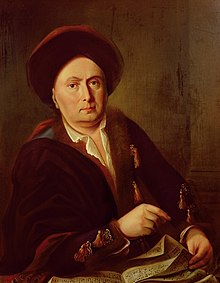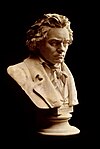In this Dutch name, the surname is van Beethoven, not Beethoven.
| Ludwig van Beethoven | |
|---|---|
 Portrait by Amelius Radoux, 1773, now in the Beethoven House, Bonn Portrait by Amelius Radoux, 1773, now in the Beethoven House, Bonn | |
| Born | Lodewijk van Beethoven c. (1712-01-05)January 5, 1712 Mechelen, Duchy of Brabant |
| Died | December 24, 1773(1773-12-24) (aged 61) Bonn, Electorate of Cologne, Holy Roman Empire |
| Other names | Ludwig van Beethoven Sr. |
| Occupations |
|
| Spouse | Maria Josepha Poll |
| Children | 3, including Johann van Beethoven |
| Relatives | Ludwig van Beethoven (grandson) |
Ludwig "Ludovicus" van Beethoven the Elder (né Lodewijk van Beethoven, Dutch: [ˈloːdəʋɛik fɑm ˈbeːt(ɦ)oːvə(n)]; c. January 5, 1712 – December 24, 1773) was a Flemish professional singer and music director, best known as the grandfather of the composer Ludwig van Beethoven.
Ancestry and birth
The family name means "from (van) a place called Beethoven" – possibly Bettenhoven.
A number of authors, such as Alexander Wheelock Thayer and Donald W. MacArdle in his book The Family van Beethoven, point to the fact that in 1712 two boys named Ludwig van Beethoven were born. The two families were distantly related.
- Ludwig van Beethoven, born January 5, 1712, in Mechelen, son of Michael van Beethoven
- Ludwig van Beethoven, born December 23, 1712, in Antwerp, son of Henry Adelard van Beethoven
He further writes that it is not certain "which Ludwig" actually settled in Bonn in 1733. The first biographer of the composer Beethoven "made no attempt to trace his genealogy beyond his grandfather Ludwig".
The Ludwig van Beethoven from Mechelen, generally assumed to be Beethoven's grandfather, was the second son of master baker Michael van Beethoven (baptized February 15, 1684 in Mechelen, died June 28, 1749, in Bonn) and his wife Maria Louise Stuyckers (April 24, 1685, Mechelen – December 8, 1749, Bonn). Michael van Beethoven, besides the bakery trade, participated also in the local real estate market and in the purchase and sale of antique furniture and paintings.
Michael van Beethoven had three other children:
- Kornelius van Beethoven (baptized September 25, 1708, Mechelen, died July 16, 1764, Bonn)
- Ludwig van Beethoven (baptized June 23, 1710 in Mechelen, died September 22, 1710, Mechelen)
- Lambert Michael van Beethoven (baptized July 25, 1715, Mechelen, died September 21, 1715, Mechelen)
Life
On December 10, 1717, going on the age of just six years, Ludwig van Beethoven the Elder, having "a beautiful voice", was granted admission to the choir boys seminar of the St. Rombout's Cathedral in Mechelen, effectively becoming a choirboy.
On October 12, 1725, he began studies under Anton Colfs, chief organist and carillonneur of St. Rumbold's Cathedral. Instruction focused on tablature and figured bass as well as the harpsichord and organ. No records exist of the years following the end of his apprenticeship in spring of 1727.
On November 9, 1731, he became a tenor singer at St. Peter's Church in Leuven; he is also mentioned as a substitute for the Kapellmeister. This appointment was probably promoted by Rombout van Kiel, a canon of the St. Peter's Church and former classmate of father Michael van Beethoven.
By September 2, 1732, Beethoven is registered as a bass singer at Saint Lambert's Cathedral, Liège. This new appointment might be attributed to the support of Francois Stoupy, director of the Liège College in Leuven and friend of Rombout van Kiel.
In March 1733 Archbishop of Cologne and Prince-elector Clemens August of Bavaria summoned Beethoven to his court in Bonn after he had heard him sing in Liege, where Beethoven had been a substitute conductor:
"Once Ludwig van Beethoven senior was established there, his destitute parents also fled to Bonn."
In Bonn, Ludwig sang under the Kapellmeister Girolamo Donnini from 1733 until Donnini's death in 1752. His long-cherished hopes of one day becoming Kapellmeister himself went unfulfilled in 1760 when a much younger colleague, Joseph Touchemoulin, got the assignment instead. Unlike Beethoven, Touchemoulin was an experienced violinist and an accomplished composer.
On February 6, 1761, upon the death of Archbishop Clemens August of Bavaria, his successor Maximilian Friedrich von Königsegg-Rothenfels immediately began to implement strict austerity measures. Ludwig van Beethoven the Elder was made new Kapellmeister with the duties of singer and conductor combined. The disillusioned Touchemoulin consequently left Bonn to find work in Regensburg. As a separate occupation Ludwig van Beethoven the Elder maintained a wine trade business, which he had developed over the course of many years, exporting Rhine and Moselle wine to Flanders. Nothing is known about the volume, success and profitability of these undertakings.
On December 24, 1773, Ludwig van Beethoven the Elder died from a stroke in Bonn. Although he bequeathed debts to his son Johann, the father's holdings in commodities that were also bestowed on the son more than made up the difference, resulting in the total inheritance having a net surplus.
Family
On November 17, 1733, Ludwig van Beethoven the Elder married Maria Josepha Poll (born Ball) (born about 1714, died September 30, 1775, Bonn). The marriage produced three children:
- Maria Ludovica Bernhardine van Beethoven (baptized August 28, 1734, Bonn, died October 17, 1735, Bonn)
- Mark Joseph van Beethoven (baptized April 25, 1736, Bonn, died unknown)
- Johann van Beethoven (born c. 1740, probably in Bonn, died December 18, 1792, Bonn); father of the composer Ludwig van Beethoven
The family of Ludwig van Beethoven the Elder initially resided in the former Jesuit college in Wenzelgasse, then in an estate, owned by master baker Fischer in Rheingasse 386 and finally in a coaching inn in Bonngasse 386, opposite the Beethoven-Haus, (Bonngasse 515).
Maria van Beethoven was to become an alcoholic, which resulted in her being placed in a clinic until her death in 1775, and his son Johann was ultimately to descend into alcoholism as well. Their alcoholism may have been related to the family wine trade business.
Assessments
Master baker Fischer described the appearance of Ludwig van Beethoven the Elder, of whom Amelius Radoux (1704 – c. 1773) had produced a contemporary oil portrait, as follows: "Stature of the court's Kapellmeister: A big beautiful man, learned man's face, broad forehead, round nose, large eyes, full red cheeks, very serious face". According to physician Franz Gerhard Wegeler, who later became a childhood friend of the composer Ludwig van Beethoven, Ludwig the Elder "was a small, vigorous man with extremely lively eyes".
Fischer and Wegeler describe him as a man with a serious and honorable character, diligent in professional practice and financial management, as well as being generally helpful and sociable.
Although his famous grandchild Ludwig van Beethoven was only three years old when Ludwig van Beethoven the Elder died, the younger Beethoven apparently had clear memories of his grandfather and developed a lasting love and admiration for him. In each of the countless times he changed lodgings during his years in Vienna, Beethoven would carry the Radoux oil portrait of his grandfather in person hurrying "to award it a place of honor" in the new home.
References
- "Ludovicus Van Beethoven". geneanet org. Retrieved December 23, 2015.
- "The Family van Beethoven Donald W. MacArdle". The Musical Quarterly. 35 (4). Oxford University Press: 528–550. October 1949. doi:10.1093/mq/xxxv.4.528. JSTOR 739876.
- Alexander Wheelock Thayer; Elliot Forbes (March 1992). Thayer's Life of Beethoven. Vol. 1. ISBN 9780691027173. Retrieved December 23, 2015.
- "Ludwig van Beethoven's family tree". Association Beethoven France. Retrieved December 23, 2015.
- "Lodewijk van Beethoven". geni com. Retrieved December 23, 2015.
- ^ "Beethoven's Family". raptus association. Archived from the original on December 23, 2015. Retrieved December 23, 2015.
- "Life – The first musician in the family was grandfather..." beethoven org. Retrieved December 23, 2015.
- James L. Jackman (2001). "Donnini, Girolamo". Grove Music Online. Oxford University Press. doi:10.1093/gmo/9781561592630.article.08008.
- "Ludwig van Beethoven Großvater und Bonner Kurfürst". martinschlu. Retrieved December 23, 2015.
- "Ludwig van Beethoven (1712–73) Beethoven's grandfather". classicfm com. Retrieved December 23, 2015.
- "Johann van Beethoven : biographie". ymphozikinfo. Retrieved December 23, 2015.
- Comini, Alessandra (2008). The Changing Image of Beethoven: A Study in Mythmaking. ISBN 9780865346611. Retrieved December 23, 2015.
- "Amelius Radoux (1704–1773?), Ludwig van Beethoven (d. Ä.) (1712–1773) ... he always took it with him whenever he moved to another house". Bonn: Beethoven House. Retrieved December 23, 2015.
Further reading
- Ludwig van Beethoven d. Ä., in Joseph Schmidt-Görg: Beethoven – Die Geschichte seiner Familie, Beethoven House Bonn, G. Renle Verlag München Duisburg, 1964, pp. 52–57
- Das große Vorbild: Großvater Louis van Beethoven, in: Jan Caeyers: Beethoven – Der einsame Revolutionär, C. H. Beck-Verlag, 2013, ISBN 978-3-406-65625-5, pp. 29–39
External links
 Media related to Ludwig van Beethoven d. Ä. at Wikimedia Commons
Media related to Ludwig van Beethoven d. Ä. at Wikimedia Commons- Beethoven House Bonn
| Ludwig van Beethoven | ||
|---|---|---|
| List of compositions | ||
| Life |  | |
| Music | ||
| Memorials | ||
| Depictions |
| |
| Family | ||
| Related | ||